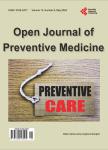Characterization of Tuberculosis Cases Presenting in a Tertiary Healthcare Facility in South-Eastern Nigeria
Characterization of Tuberculosis Cases Presenting in a Tertiary Healthcare Facility in South-Eastern Nigeria作者机构:Department of Community Medicine Nnamdi Azikiwe University Teaching Hospital Nnewi Nigeria Department of Nursing Science College of Health Sciences Nnamdi Azikiwe University Awka Nigeria
出 版 物:《Open Journal of Preventive Medicine》 (预防医学期刊(英文))
年 卷 期:2014年第4卷第9期
页 面:723-729页
学科分类:1002[医学-临床医学] 100214[医学-肿瘤学] 10[医学]
主 题:Characteristics Tuberculosis Patients DOTS Nigeria
摘 要:Background: Tuberculosis is second only to HIV/AIDS as the greatest killer worldwide, due to a single infectious agent. Directly Observed Treatment Short-Course (DOTS) is presently the WHO recommended programme to fight tuberculosis worldwide. There is need to understand the characteristics of patients who receive treatment for tuberculosis. This will help modify the strategies to fight the scourge of tuberculosis. Methods: This was a retrospective study conducted at the DOTS clinic at Nnamdi Azikiwe University Teaching Hospital Nnewi, Anambra State, Nigeria. The records of patients who received treatment from the clinic from 1st January 2012 to 31st December 2012 were reviewed. Three hundred and fifteen patients were included in the study. Important characteristics of the patients were retrieved. Associations between patients’ characteristics were determined using relevant tests of significance. Results: Three hundred and fifteen patients were included in the study. There were more male patients (59%). The reproductive age group (37.5%) was more than the other age groups. Mean age was 33.1 (±18.5) years. There were more rural patients (50.2%) than urban patients (49.8%). There were more pulmonary TB patients (87.3%) than extrapulmonary TB patients (12.7%). There were more sputum AFB negative patients (45.4%) than positive patients (41.3%). There were more HIV negative patients (59.4%) than positive patients (40.6%). Conclusion: This study demonstrated some important characteristics of tuberculosis patients. Such knowledge if taken into consideration in the tuberculosis control programme will definitely improve the outcome of the programme.



